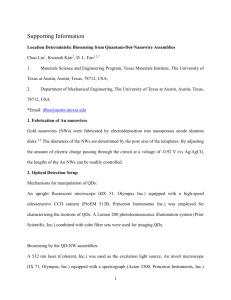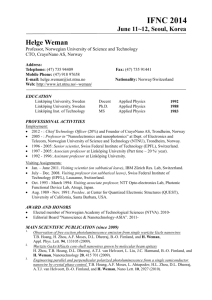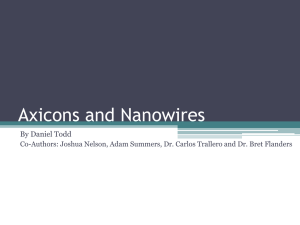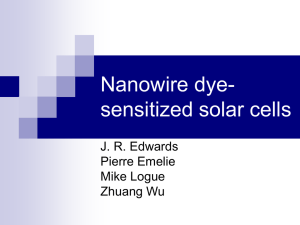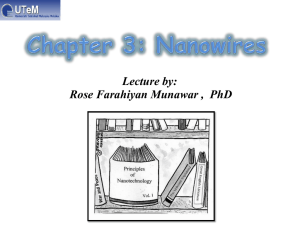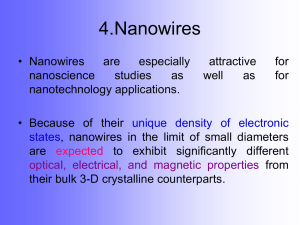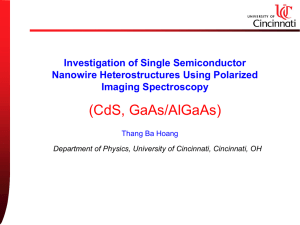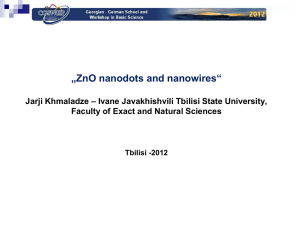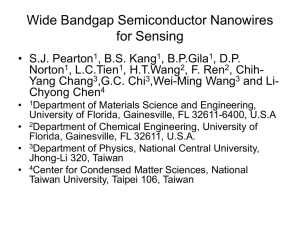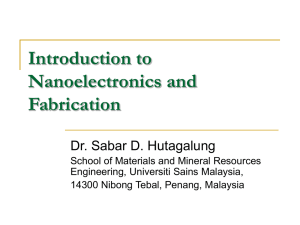(4 CB), 5. ledge
advertisement
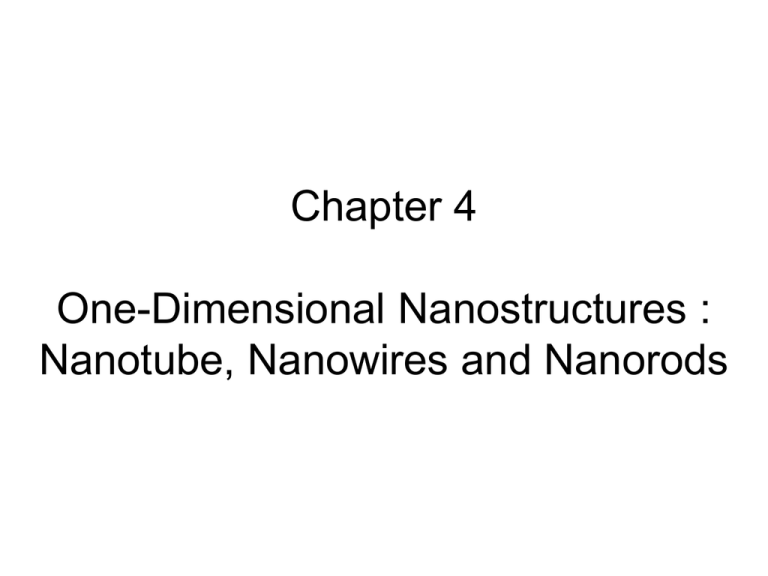
Chapter 4
One-Dimensional Nanostructures :
Nanotube, Nanowires and Nanorods
Synthesis Methods
• Bottom up:
Spontaneous Growth
• A growth driven by reduction of Gibbs free
energy or chemical potential. This can be
from either recrystallization or a decrease
in supersaturation.
• Growth along a certain orientation faster
than other direction – anisotropic growth.
• For nanowire, growth occurs only along
one direction, but no growth along other
directions.
Evaporation (Dissolution) –
Condensation Growth
Rate Limiting Steps
• Step 2 can be rate limiting if the supersaturation
or concentration of growth species is low.
• When a sufficient supersaturation or a high
concentration of growth species is present, Step
4 will be the rate-limiting process.
• Either adsorption-desorption of growth species
on the growth surface (step 2) or surface growth
(step 4) can be rate limiting process.
Step 2 is rate limiting process
• The growth rate is determined by condensation rate, J
(atoms/cm2sec).
• J = ασPo/(2πmkT)2,
• Where α is the accommodation coefficient, and σ= (P –
Po)/Po and is the supersaturation of the growth species in
the vapor in which Po is the equilibrium vapor pressure
(or concentration of the growth species in the vapor) of
the crystal at temperature T, m is the atomic weight of
the growth species, k is the Boltzmann constant, αis the
fraction of impinging growth species that becomes
accommodated on the growing surface, and is a surface
specific property. A significant difference in α in different
facets would result in anisotropic growth.
The impinging growth species onto the surface is
function of residence time and /or diffusion
distance before escapting back to the vapor phase.
Step Growth or KSV Theory
4. Kink site (4 CB), 5. ledge-kink
site (3 CB), 7. adatom (1 CB,
unstable), 8. ledge site (2 CB)
BCF Theory – presence of screw
dislocation ensures continuous growth
and enhances the growth rate
Mechanism leading to formation of
nanowire
• The growth rate of a facet increases with
an increased density of screw dislocations
parallel to the growth direction. It is known
that different facets can have a
significantly different ability to
accommodate dislocations. The presence
of dislocations on a certain facet can result
in anisotropic growth, leading to the
formation of nanowire or nanorods.
PBC Theory
(100), F-face, unstable
(110), S-face
(111), K-face
Mechanism leading to Anisotropic
Growth
• Therefore, α = 1 for {111} and {110}, α< 1 for {100}. This
leads to that growth rate for {111}, {110} is greater than
that for {100}. For both {111} and {110}, the growth
process is always adsorption limited. Facets with high
growth rate (high surface energy) disappears while
facets with low growth rate (low surface energy) survives.
This leads to anisotropic growth and results in nanowires.
In addition, defects-induced growth and impurityinhibited growth are the possible mechanisms for growth
along axis of nanowires. A low supersaturation is
required for anisotropic growth. A higher supersaturation
supports bulk crystal growth or homogeneous nucleation
leading to formation of polycrystalline or powder.
Growth of Single Crystal Nanobelts
of Semiconducting or metal oxides
• Evaporating the metal oxides (ZnO, SnO2, In2O3,
CdO) at high temperatures under a vacuum of
300 torr and condensing on an alumina
substrate, placed inside the same alumina tube
furnace, at relatively low temperature.
• Or heating the metal oxide or metal
nanoparticles at T=780 - 820oC in air, Nanorods
can be obtained depending upon annealing T
and time. Nanowires such as ZnO, Ga2O3, MgO,
CuO or Si3N4 and SiC can be made by this
method.
By controlling growth
kinetics, a consequence of
minimizing the total
energy attributed by
spontaneous polarization
and elasticity, left-handed
helical nanostructures and
nano-rings can be formed.
Dissolution and Condensation
Growth
• The growth species first dissolve into a
solvent or a solution, and then diffuse
through the solvent and deposit onto the
surface resulting growth of nanowires.
Growth of Se Nanowires
Growth of SeTe Nanowires
Growth of Ag Nanowire Using Pt
Nanoparticles as Growth Seeds
•
•
•
•
Precursor: AgNO3
Reduction agent: ethylene glycol
Surfactant: polyvinyl pyrrolidone (PVP)
The surfactant absorbed on some growth
surfaces and blocks the growth, resulting
in the formation of uniform crystalline silver
nanowires.
Disadvantages of Evaporation –
Condensation Deposition
• Nanowire grown by EC most likely have
faceted morphology and are generally
short in length with relatively small aspect
ratios, particular when grown in liquid
medium. However, anisotropic growth
induced by axial imperfections, such as
screw dislocation, microtwins and stacking
faults, or by impurity poisoning, can result
in the growth of nanowires with large
aspect ratios.
Vapor (or solution)-Liquid-solid
(VLS) Growth
It is noted that the surface of liquid has a large accommodation
coefficient, and is therefore a preferred site for deposition.
Wagner summarized the requirements for
VLS growth over
years ago.
30
VLS Growth Process
The growth rate for VLS is much
faster
• The liquid surface can be considered as a rough
surface. Rough surface is composed of only
ledge, ledge-kink, or kink sites. That is, every
site over the entire surface is to trap the
impinging growth species. The accommodation
coefficient is unity. It is reported that the growth
rate of silicon nanowire using a liquid Pt-Si alloy
is about 60 times higher than directly on the
silicon substrate at 900oC.
• The liquid acts as a sink for the growth species
in the vapor phase, it also act as a catalyst for
the heterogeneous reaction or deposition.
Compound Semiconductor
Nanowires
• Nanowires of binary group III-V materials
(GaAs, GaP, InAs, and InP), ternary
III-V materials (GaAs/P, InAs/P), binary IIVI compounds (ZnS, ZnSe, CdS, and
CdSe), and binary IV-IV SiGe alloys have
been made in bulk quantities as high purity
(>90%) single crystals.
Table 1. Summary of single crystal nanowires synthesized. The growth temperatures correspond to ranges explored
in these studies. The minimum and average nanowire diameters were determined from TEM and FESEM
images. Structures were determined using electron diffraction and lattice resolved TEM imaging: ZB, zinc
blende; W, wurtzite; and D, diamond structure types. Compositions were determined from EDX measurements
made on individual nanowires. All of the nanowires were synthesized using Au as the catalyst, except GaAs, for
which Ag and Cu were also used. The GaAs nanowires obtained with Ag and Cu catalysts have the same size
distribution, structure, and composition as those obtained with the Au catalyst.
Choice of Catalyst
• The catalysts for VLS growth can be chosen in the
absence of detailed phase diagrams by identifying
metals in which the nanowire component elements are
soluble in the liquid phase but that do not form solid
compounds more stable than the desired nanowire
phase; i.e., the ideal metal catalyst should be physically
active but chemically stable. From this perspective the
noble metal Au should represent a good starting point for
many materials. This noble metal also has been used in
the past for the VLS growth of surface supported
nanowires by metal-organic chemical vapor deposition
(MOCVD).
In general, the nanowires grown by VLS have a cylindrical morphology,
i.e. without facets on the side surface and having a uniform diameter.
This is attributed to the growth at a temperature greater than the
roughening temperature (surface undergoing a transition from faceted
(smooth) to rough surface).
VLS Growth of Nanowires
• Precursors: Compound gas (e.g. SiCl4),
evaporation of solids, Laser ablation of
solid targets.
Methods for Growth of CNTs
Furnace at 1200 C
Water-cooled
copper
collector
Ar
gas
Laser Ablation Process
Nanotube growing
along tip of
collector
Laser
Formation of
nanotubes
Graphite
target
Note: The target may be
made by pressing Si
powder mixed with 0.5%
iron.
Power Supply
Water in
in
Water out
out
out
Water
in
Water
Arc-Discharge System
He
mass flow controller
graphite
anode
graphite, cathode
auto pressure controller
pump
Advantages of Oxide Assisted
Growth (OAG) Si Nanowires
pp. 635-640.
SLS Growth of InP Nanowires
Growth of Silicon Nanowires by SLS method
Template-Based SynthesisElectrochemical Deposition
Electroless Electrolysis
Using polycarbonate
membrane as template –
Electrochemical Deposition
(for conducting polymer) or
electroless electrolysis (for
polymer)
Electrophoretic Deposition
Stabilization of colloids is generally achieved by electrostatic
double layer mechanism.
Using polycarbonate
membrance as template
Template Filling
Template Filling
Incomplete Filling of the Template
Template Filling Assisted with
Centrifugation Force
Centrifugation Force which must be greater than the repulsion force between
particles
Converting Through Chemical
Reactions
Electrospining – using electric forces
(overcome surface tension) to porduce
polymer fibers

